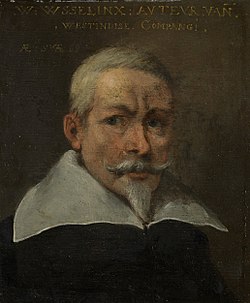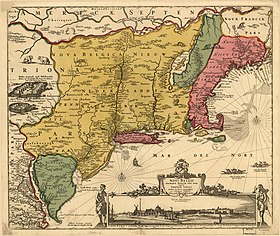Willem Usselincx
Willem Usselincx | |
|---|---|
 Willem Usselincx, 1637 | |
| Born | 1567 |
| Died | c. 1647 (aged 79–80) |
| Occupation | Merchant |
| Known for | Founder of the Dutch West India Company |
| Signature | |
Willem Usselincx (1567 – c. 1647) was a Flemish Dutch merchant, investor and diplomat who was instrumental in drawing both Dutch and Swedish attention to the importance of the New World. Usselincx was the founding father of the Dutch West India Company.[1]
Background
Usselincx was born in
The religious revolution of the
Dutch West India Company

Usselincx had spent some time in Spain, Portugal and on the
His book Naerder Bedenckingen, Over de zee-vaert/ Coophandel ende Neeringhe alsmede de versekeringhe vanden Staet was first printed in 1608.[8] This work translated into English as "Further reflections on the navigation, commerce and trade, and building of the state", presented Usselincx's arguments for a West India trading company and made frequent reference to the Spanish power and source of wealth in the West Indies.[9]
In 1621, Usselincx was one of the founding fathers of the
Swedish South Company

Usselincx, drew the attention of Peter Minuit to Swedish efforts to found the colony which would later become New Sweden (Swedish: Nya Sverige). Like his friend Usselincx, Peter Minuit had also been disappointed by the Dutch West India Company and was replaced as governor of New Amsterdam.
As early as 1626, Usselinx had described the advantages to Sweden of contributing in an overseas venture. He referred to the wealth acquired by Spain and The Netherlands in similar enterprises and extolled Sweden's resources for success in the marketplace. Usselinx received royal privileges from king
Usselincx relocated from The Netherlands to Sweden but the process of the founding of the new company was difficult and time-consuming,[14] despite the support of Axel Oxenstierna, Swedish Lord High Chancellor. Its charter included Swedish, Dutch, and German stockholders led by directors of the New Sweden Company.[15][12] In 1637, Minuit made arrangements with Samuel Blommaert and the Swedish government to create New Sweden, the first Swedish colony in the New World. But by that time, Usselincx was largely financially ruined due to bad investments and unable to profit from his vision. Between 1638 and 1655, the company sponsored 11 expeditions to Delaware in 14 separate voyages (two did not survive).
In 1649 the Swedish South Company lost its monopoly on tobacco, granted by the king of Sweden in 1641. In 1655 New Sweden was annexed by New Netherland, this brought an end to the activities of the Swedish South Company, it was dissolved in 1680.
The Swedish East India Company (Swedish: Svenska Ostindiska Companiet or SOIC) would not be founded until 1731 for the purpose of conducting trade with the far east.[16][17]
References
- ^ Franklin J. Jameson (1887). Willem Usselinx, Founder of the Dutch and Swedish West India Companies. Johns Hopkins University, New York.
- ^ "Focus on the Port: Port History". Archived from the original on 11 October 2008. Retrieved 3 May 2009.
- ^ Alfons K. L. Thijs, Van Geuzenstad tot katholiek bolwerk: Maatschappelijke betekenis van de kerk in contrareformatorisch Antwerpen (Antwerp, 1990), p. 102.
- ISBN 978-0-09-131051-6Google books Archived 13 March 2017 at the Wayback Machine
- ISBN 978-90-5875-140-9
- ^ History of Delaware County, Pennsylvania Archived 25 March 2010 at the Wayback Machine (by Henry Graham Ashmead. Philadelphia: L. H. Everts & Co. 1884)
- ^ The Crisis of the Seventeenth Century: Religion, the Reformation and Social Change Archived 9 August 2010 at the Wayback Machine by Hugh Trevor-Roper, Indianapolis: Liberty Fund, 2001
- ^ Full title: Naerder Bedenckingen, Over de zee-vaert/ Coophandel ende Neeringhe alsmede de versekeringhe vanden Staet deser vereenichde Landen/ inde teghenvoordighe Vrede-handelinghe met den Coninck van Spangnien ende de Aerts-hertoghen.
- ^ Full translation: "Further reflections on the Navigation, Commerce and Trade, as also the assurance of the Government of those United Lands in the present Treaty of Peace with the King of Spain and the Archdukes, by a lover of real and constant peace"
- ^ The Dutch Republic, its rise, greatness and fall. 1477-1806 (by J. Israel, Oxford: 1998). https://translate.google.com/translate?hl=en&sl=nl&u=http://ahc.ruhosting.nl/vg/html/vg000319.htm&ei=3534SYHgO6PQMvnBrbMP&sa=X&oi=translate&resnum=10&ct=result&prev=/search%3Fq%3DWillem%2BUsselincx%26hl%3Den%26sa%3DN%26start%3D10 Archived 8 November 2012 at the Wayback Machine
- ^ "Story of the City's Early Days" Archived 30 September 2022 at the Wayback Machine (Chapter II, The Dutch West India Company. by Thomas A. Janvier, The New York Times. Published: May 31, 1903)
- ^ ISBN 978-0-8071-5060-3. Archivedfrom the original on 11 August 2021. Retrieved 26 October 2016.
- ^ which included parts of Norway and Finland, parts of the Baltic states, parts of Germany and parts of Denmark.
- ^ because of the wars Sweden was involved in (with the catholics in the south), there were many setbacks, most of the funds he raised for the company were initially even used by the king for building a military fleet.
- ^ "A Brief History of New Sweden in America". The Swedish Colonial Society. Archived from the original on 11 December 2005. Retrieved 24 October 2017.
- The Pennsylvania Magazine of History and Biography, Vol. 7, No. 3 pp. 268-270. 1883)
- ^ The History of the Colony of New Sweden Archived 30 October 2021 at the Wayback Machine (Carl K. S. Sprinchorn's "Kolonien Nya Sveriges Historia", English translation by Gregory B. Keen in the Pennsylvania Magazine of History and Biography, vols. vii. and viii. 1878)
Other sources
- Fiske, John The Dutch and Quaker Colonies in America (New York: Houghton Mifflin, 1902). https://archive.org/details/dutchandquaker01fiskrich/mode/2up
- Jameson, J. Franklin Willem Usselinx: Founder of the Dutch and Swedish West India Companies (G.P. Putnam's Sons. 1887). https://archive.org/details/willemusselinxf00jamegoog/mode/2up
- Mickley, Joseph J. Some Account of William Usselinx and Peter Minuit: Two individuals who were instrumental in establishing the first permanent colony in Delaware (The Historical Society of Delaware. 1881)
- Johnson, Amandus The Swedes on the Delaware, 1638-1664 (Philadelphia, PA: The Swedish Colonial Society. 1915)
